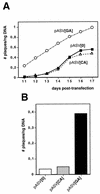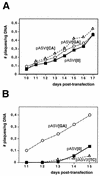d(GA x TC)(n) microsatellite DNA sequences enhance homologous DNA recombination in SV40 minichromosomes
- PMID: 11095670
- PMCID: PMC115175
- DOI: 10.1093/nar/28.23.4617
d(GA x TC)(n) microsatellite DNA sequences enhance homologous DNA recombination in SV40 minichromosomes
Abstract
The genomic distribution of the abundant eukaryotic d(GA x TC)(n) DNA microsatellite suggests that it could contribute to DNA recombination. Here, it is shown that this type of microsatellite DNA sequence enhances DNA recombination in SV40 minichromosomes, the rate of homologous DNA recombination increasing by as much as two orders of magnitude in the presence of a d(GA x TC)(22) sequence. This effect depends on the region of the SV40 genome at which the d(GA x TC)(22) sequence is cloned. It is high when the sequence is located proximal to the SV40 control region but no effect is observed when located 3.5 kb away from the SV40 ori. These results indicate that the recombination potential of d(GA x TC)(n) sequences is likely linked to DNA replication and/or transcription. The potential contribution of the structural properties of d(GA x TC)(n) sequences to this effect is discussed.
Figures




Similar articles
-
SV40 recombinants carrying a d(CT.GA)22 sequence show increased genomic instability.Gene. 1991 Dec 15;108(2):269-74. doi: 10.1016/0378-1119(91)90444-g. Gene. 1991. PMID: 1660839
-
Recombination between poly[d(GT).d(CA)] sequences in simian virus 40-infected cultured cells.Mol Cell Biol. 1985 Jun;5(6):1247-59. doi: 10.1128/mcb.5.6.1247-1259.1985. Mol Cell Biol. 1985. PMID: 2993859 Free PMC article.
-
Circular and linear simian virus 40 DNAs differ in recombination.Mol Cell Biol. 1985 Apr;5(4):869-80. doi: 10.1128/mcb.5.4.869-880.1985. Mol Cell Biol. 1985. PMID: 2985972 Free PMC article.
-
Simian virus 40 illegitimate recombination occurs near short direct repeats.J Mol Biol. 1984 Jul 25;177(1):53-68. doi: 10.1016/0022-2836(84)90057-3. J Mol Biol. 1984. PMID: 6086940
-
Analysis of recombination in mammalian cells using SV40 and SV40-derived vectors.Mutat Res. 1989 Mar-May;220(2-3):221-34. doi: 10.1016/0165-1110(89)90026-2. Mutat Res. 1989. PMID: 2538740 Review.
Cited by
-
A genome-wide map of adeno-associated virus-mediated human gene targeting.Nat Struct Mol Biol. 2014 Nov;21(11):969-75. doi: 10.1038/nsmb.2895. Epub 2014 Oct 5. Nat Struct Mol Biol. 2014. PMID: 25282150 Free PMC article.
-
Distinct mutational behaviors differentiate short tandem repeats from microsatellites in the human genome.Genome Biol Evol. 2013;5(3):606-20. doi: 10.1093/gbe/evs116. Genome Biol Evol. 2013. PMID: 23241442 Free PMC article.
-
Detecting microsatellites within genomes: significant variation among algorithms.BMC Bioinformatics. 2007 Apr 18;8:125. doi: 10.1186/1471-2105-8-125. BMC Bioinformatics. 2007. PMID: 17442102 Free PMC article.
-
Genomic correlates of recombination rate and its variability across eight recombination maps in the western honey bee (Apis mellifera L.).BMC Genomics. 2015 Feb 21;16(1):107. doi: 10.1186/s12864-015-1281-2. BMC Genomics. 2015. PMID: 25765996 Free PMC article.
-
Revealing structural peculiarities of homopurine GA repetition stuck by i-motif clip.Nucleic Acids Res. 2021 Nov 18;49(20):11425-11437. doi: 10.1093/nar/gkab915. Nucleic Acids Res. 2021. PMID: 34718718 Free PMC article.
References
-
- Manor H., Rao,B.S. and Martin,R.G. (1988) Abundance and degree of dispersion of genomic d(GA)n.d(TC)n sequences. J. Mol. Evol., 27, 96–101. - PubMed
-
- Birnboim H.C., Sederoff,R.R. and Paterson,M.C. (1979) Distribution of polypyrimidine·polypurine segments in DNA from diverse organisms. Eur. J. Biochem., 98, 301–307. - PubMed
-
- Collier D.A., Griffin,J.A. and Wells,R.D. (1988) Non-B right-handed DNA conformations of homopurine.homopyrimidine sequences in the murine immunoglobulin Cα switch region. J. Biol. Chem., 263, 7397–7405. - PubMed
-
- Richards J.E., Gilliam,A.C., Shen,A., Tucker,P.W. and Blattner,F.R. (1983) Unusual sequences in the murine immunoglobulin µ–δ heavy-chain region. Nature, 306, 483–487. - PubMed
-
- Weinreb A., Collier,D.A., Birshtein,B.K. and Wells,R.D. (1990) Left-handed Z-DNA and intramolecular triplex formation at the site of an unequal sister chromatid exchange. J. Biol. Chem., 265, 1352–1359. - PubMed

